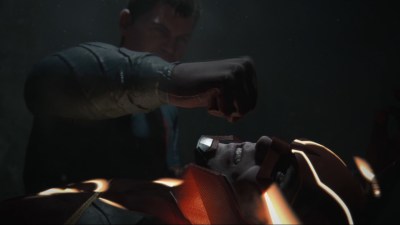For a medium made up of creators who aim to provide joyful entertainment, video game developers absolutely love to end the world, with such alarming regularity that the End Times aren’t so much a dramatic cessation of mankind’s actvities on Earth but a mere foootnote, a convenient setup for whatever world-in-peril premise a studio can come up with in order to bankroll its latest project.
Over the years, we’ve seen video games posit the end of human civilization as we know it via nuclear war (Fallout ), natural disaster (Submerged) and that old standby, a Zombie outbreak (Day Z and God knows how many others). Uniting all of those games, which number in the hundreds and span pretty much every single genre you can think of, is a common theme: that mankind’s dominance over the world will come not as a quiet sigh, but a violent scream.
In Everybody’s Gone To The Rapture, from Dear Esther and Amnesia: A Machine For Pigs developer The Chinese Room (with assistance from Sony Santa Monica), humanity’s end comes not via some violent world-devastating event, but is instead caused by something altogether more subdued: a quiet apocalypse preempted by strange fluttering lights, nosebleeds and a sudden spate of disappearances.
Everybody’s Gone To The Rapture is a decidedly English game. Not just because it’s set in a sleepy village in the English county of Shropshire - complete with rain, wheat fields and a traditional windmill - but because The Chinese Room’s vision of the end of world feels so polite. It’s easy to imagine that when the end came, the inhabitants of Yaughton Valley formed an orderly line and waited patiently for their turn to meet their maker. Perhaps they even had scones and a nice pot of tea to bide the time.
Like Dear Esther before it, Everybody’s Gone To The Rapture is entirely non-violent. It is, to use an utterly disdainful phrase, a walking simulator. It certainly features more interaction than Dear Esther, but make no mistake: Everybody’s Gone To The Rapture is not an action-packed experience. Instead, it’s a game to savor, one where you soak up the atmosphere of the sleepy village which makes up its world as you attempt to piece together the mystery that forms the central thrust of its gentle narrative.
Central to the experience is a small ensemble of well-rounded characters whose lives are all interconnected. You never meet them in person, but they’ve left traces of themselves behind in the form of a series of miniature interactions, which piece together the events leading up to the inevitable apocalypse.
Each character gets his or her time in the spotlight, with the game being roughly divided into six acts that devote themselves fully to rounding out their personality and story.
It’s here where Everybody’s Gone To The Rapture shines the brightest. Every one of the central characters is superbly written and acted, and while you never see them in detail - small pinpricks of golden light create a rough silhouette of their outline, with movements suggested rather than explicitly shown - you’ll build up a mental image of them as you imagine they would appear in real life.
There’s Steven, the obsessive scientist desperately trying to get to the bottom of just what is going on, who you can imagine wearing horn-rimmed glasses that he pushes compulsively up the bridge of his nose as he scratches the gangly dark hair back of his head. And there’s Wendy, a curmudgeonly and interfering old woman who insists on meddling in the love lives of others. Other characters include local vicar Jeremy and abrasive handyman Frank. Each has their own quirks and foibles, displaying the character flaws which make us all individual personalities, rather than merely puppets in a stage play.
Every cast member has their own small tale to tell, their own place in the overarching narrative. What impresses the most is that The Chinese Room could have easily allowed itself to be swept away by the supernatural fantasy of its premise, but instead it zeroes in on these characters, focusing on the human aspect of ordinary lives impacted by extraordinary circumstance.
As with Dear Esther, your interaction with the world is minor to the point of negligible. You’ll spend the entirety of your time merely walking around the fictional village of Yaughton Valley, stopping to appreciate a particularly lovely view. Occasionally, you’ll press a button to open a door or gate, activate a tape recorder, or answer a ringing phone. That’s it. There are no puzzles, no platforming sections, no mechanics of any kind to act as a barrier between the player and the narrative.
This shouldn’t come as too much of a surprise, given that The Chinese Room effectively defined this kind of experiential gaming with its debut offering Dear Esther. Some will likely find it off-putting. Others will accuse the studio of being “artsy” and pretentious. But to do would be to undermine what The Chinese Room and Sony Santa Monica have crafted, which is an experience just as worthy of your time as anything released this year. Yaughton Valley is thoroughly believable as a setting, so much so that you wouldn’t be surprised to come across it during a lazy Sunday afternoon drive, or find it captured on a postcard.
Yaughton Valley is undoubtedly a romanticized vision of English country life - populated by barns stacked with hay bales and quaint pubs offering discounted local ale; but wandering down its streets and pathways can make you yearn for a sightseeing holiday, and the scenery offers up plenty of inviting opportunities to make use of the Dualshock 4’s share button (all of the screenshots on display in this review were captured during my playthrough).
Everybody’s Gone To The Rapture may not match the sheer visual spectacle of Killzone or Bloodborne, but it doesn’t have to. It’s quietly affecting, the serenity of your surroundings seeping into your mood as you play. Not since Journey have I come away feeling so relaxed and finding myself wanting to return to a game not to play it, but simply to experience more of its world.
The atmosphere is further bolstered by a wonderful soundtrack, which enhances Rapture’s emotional resonance without ever coming across as overwrought. Primarily consiting of strings, piano and female soprano vocals, the music lends weight to the haunted and lonely atmosphere as you play, appearing sparingly to punctuate dramatic scenes and enhance emotional moments. It’s telling that the soundtrack is available to purchase separately, a quiet display of just how confident Sony is in the music’s ability to take hold of your senses.
Everybody’s Gone To The Rapture is a story not just about the apocalypse, but a story about love, obsession, fear and long-standing feuds. By the end of its five to six-hour running time you may not have gained the answers to many of the questions posed by its premise, but you do feel as though you’ve gotten to know a handful of new people in intimate detail. When the credits roll, you’ll feel a sense of loss that you’ll never meet these characters again.
Everybody’s Gone To The Rapture won’t be to everyone’s taste. and that’s just fine. Not so much a game as an interactive experience, The Chinese Room and Sony Santa Monica have crafted something which will stay with you long after playing. While the more immediate questions evoked by its premise remain unanswered by the end, and though it’s essentially a solitary experience, it remains a stunning accomplishment.
With great writing, lovely art design and an accomplished soundtrack, Everybody’s Gone To The Rapture more than lives up to the legacy of Dear Esther.
Mechanically sparse, it isn’t going to win everybody over, and if you’re the type of person who prefers to relax by popping off a few headshots or putting your puzzle-solving skills to work, you’re likely to wonder what all the fuss is about; but if you’re the type of gamer who enjoys immersing yourself in a setting and feeling transported to new places, then you should consider Everybody’s Gone To The Rapture an essential purchase.



Pingback: Everybody's Gone to the Rapture Studio Co-Head Leaves | Continue Play()